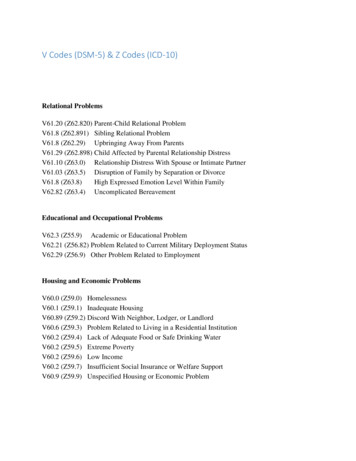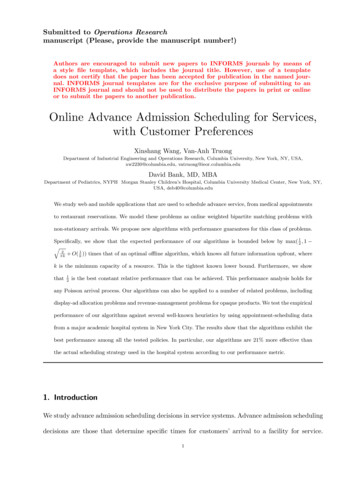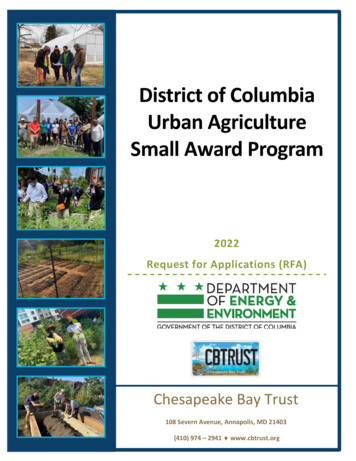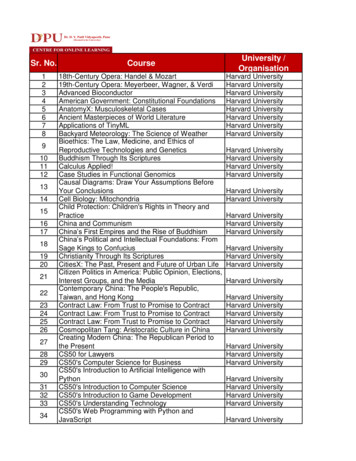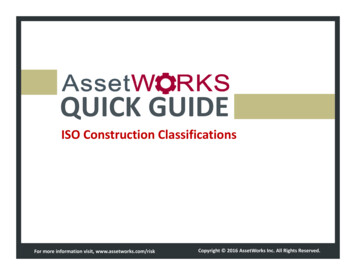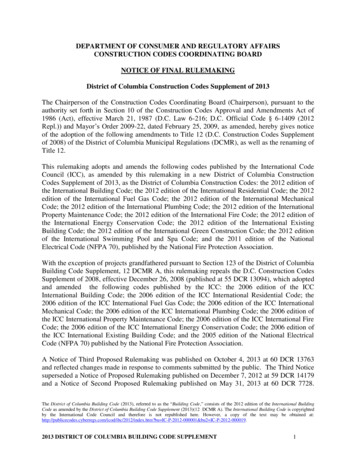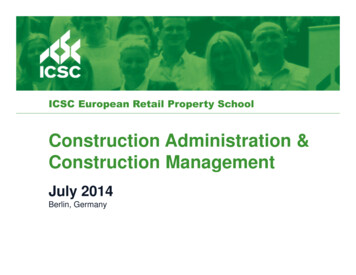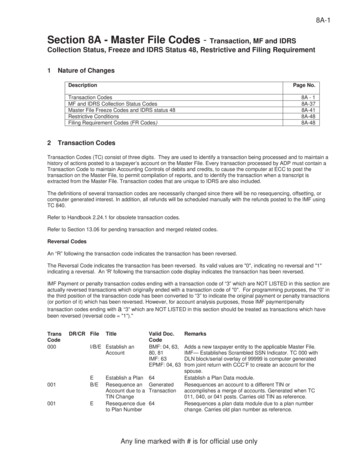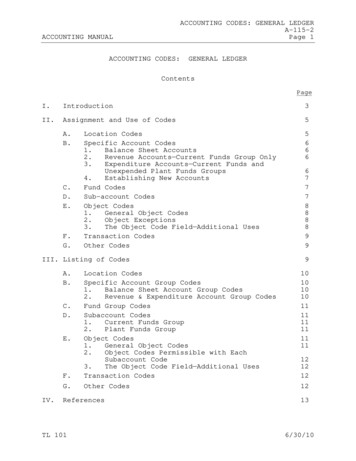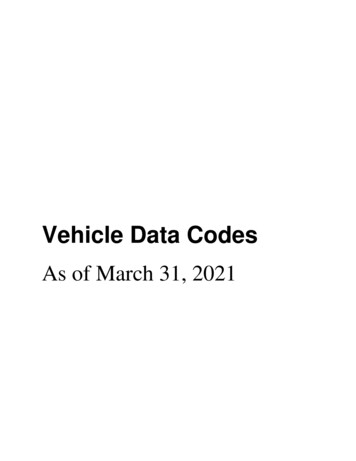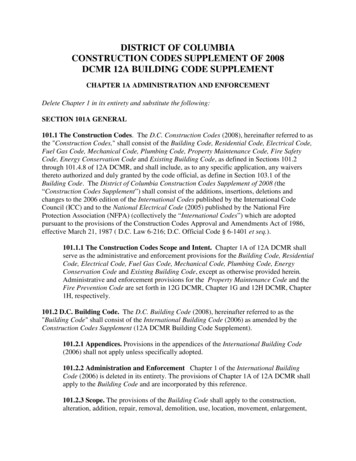
Transcription
DISTRICT OF COLUMBIACONSTRUCTION CODES SUPPLEMENT OF 2008DCMR 12A BUILDING CODE SUPPLEMENTCHAPTER 1A ADMINISTRATION AND ENFORCEMENTDelete Chapter 1 in its entirety and substitute the following:SECTION 101A GENERAL101.1 The Construction Codes. The D.C. Construction Codes (2008), hereinafter referred to asthe "Construction Codes," shall consist of the Building Code, Residential Code, Electrical Code,Fuel Gas Code, Mechanical Code, Plumbing Code, Property Maintenance Code, Fire SafetyCode, Energy Conservation Code and Existing Building Code, as defined in Sections 101.2through 101.4.8 of 12A DCMR, and shall include, as to any specific application, any waiversthereto authorized and duly granted by the code official, as define in Section 103.1 of theBuilding Code. The District of Columbia Construction Codes Supplement of 2008 (the“Construction Codes Supplement”) shall consist of the additions, insertions, deletions andchanges to the 2006 edition of the International Codes published by the International CodeCouncil (ICC) and to the National Electrical Code (2005) published by the National FireProtection Association (NFPA) (collectively the “International Codes”) which are adoptedpursuant to the provisions of the Construction Codes Approval and Amendments Act of 1986,effective March 21, 1987 ( D.C. Law 6-216; D.C. Official Code § 6-1401 et seq.).101.1.1 The Construction Codes Scope and Intent. Chapter 1A of 12A DCMR shallserve as the administrative and enforcement provisions for the Building Code, ResidentialCode, Electrical Code, Fuel Gas Code, Mechanical Code, Plumbing Code, EnergyConservation Code and Existing Building Code, except as otherwise provided herein.Administrative and enforcement provisions for the Property Maintenance Code and theFire Prevention Code are set forth in 12G DCMR, Chapter 1G and 12H DCMR, Chapter1H, respectively.101.2 D.C. Building Code. The D.C. Building Code (2008), hereinafter referred to as the"Building Code" shall consist of the International Building Code (2006) as amended by theConstruction Codes Supplement (12A DCMR Building Code Supplement).101.2.1 Appendices. Provisions in the appendices of the International Building Code(2006) shall not apply unless specifically adopted.101.2.2 Administration and Enforcement Chapter 1 of the International BuildingCode (2006) is deleted in its entirety. The provisions of Chapter 1A of 12A DCMR shallapply to the Building Code and are incorporated by this reference.101.2.3 Scope. The provisions of the Building Code shall apply to the construction,alteration, addition, repair, removal, demolition, use, location, movement, enlargement,
occupancy and maintenance of all buildings and structures, appurtenances attached tobuildings or structures, signs, advertising devices and premises in the District ofColumbia and apply to existing or proposed buildings and structures; except as suchmatters are otherwise provided for in other ordinances or statutes, or in the rules andregulations authorized for promulgation under the provisions of the Building Code. Theseregulations establish minimum maintenance standards for all structures and premises forbasic equipment and facilities for light, ventilation, space heating and sanitation; forsafety from fire; for space and location; for safe and sanitary maintenance of all structuresand premises now in existence; for minimum requirements for all existing buildings andstructures for means of egress, fire protection systems and other equipment and devicesnecessary for life safety from fire; for rehabilitation and reuse of existing structures, andconstruction and those for alterations and repairs.Exceptions:1.Detached one- and two-family dwellings and multiple single-familydwellings (townhouses) not more than three stories above grade plane inheight with a separate means of egress and their accessory structures shallbe permitted to comply with the Residential Code listed in Section 101.3.2.Existing buildings undergoing repair, alteration, additions or change ofoccupancy shall comply with the Existing Building Code listed in Section101.4.8 or the current Construction Codes.101.2.4 Intent. The purpose of the Building Code is to establish the minimum standardsto safeguard the public health, safety, and general welfare through structural strength,means of egress facilities, stability, sanitation, adequate light and ventilation, energyconservation, and safety to life and property from fire and other hazards attributed to thebuilt environment and to provide safety to fire fighters and emergency responders duringemergency operations.101.3 D.C. Residential Code. The D.C. Residential Code (2008), hereinafter referred to as the"Residential Code," shall consist of the International Residential Code (2006) as amended by theConstruction Codes Supplement (12B DCMR Residential Code Supplement).101.3.1 Appendices. Provisions in the appendices of the International Residential Code(2006) shall not apply unless specifically adopted.101.3.2 Administration and Enforcement. Chapter 1 of the International ResidentialCode (2006) is deleted in its entirety. The provisions of Chapter 1A of 12A DCMR shallapply to the Residential Code and are incorporated by this reference.101.3.3 Scope. The provisions of the Residential Code shall apply to the construction,movement, enlargement, replacement, equipment, use and occupancy, location, removaland demolition of detached one- and two-family dwellings and townhouses not more thanthree stories above-grade in height with a separate means of egress and their accessorystructures.101.3.4 Intent. The purpose of the Residential Code is to establish the minimum
standards to safeguard the public health, safety, and general welfare through affordability,structural strength, means of egress facilities, stability, sanitation, adequate light andventilation, energy conservation, and safety to life and property from fire and otherhazards attributed to the built environment and to provide safety to fire fighters andemergency responders during emergency operations.101.4 Referenced Codes. The codes listed in Sections 101.4.1 through 101.4.8 and referencedelsewhere in the Building Code shall be considered part of the requirements of the ConstructionCodes to the prescribed extent of each such reference.101.4.1 D.C. Electrical Code. The D.C. Electrical Code (2008) hereinafter referred to asthe "Electrical Code," shall consist of the National Fire Protection Association (NFPA)National Electrical Code (2005) as amended by the Construction Code Supplement(12C DCMR Electrical Code Supplement).101.4.1.1 Appendices. Provisions in the appendices of the NFPA NationalElectrical Code (2005) shall not apply unless specifically adopted.101.4.1.2 Administration and Enforcement. The provisions of Chapter 1A of12A DCMR shall apply to the Electrical Code and are incorporated by thisreference.101.4.1.3 Repeal. Article 90 of the National Electrical Code (2005) is deleted inits entirety.101.4.1.3.1 Mandatory Rules and Explanatory Material. Mandatoryrules of the National Electrical Code are characterized by the use of theword "shall." Explanatory material in the form of Fine Print Notes (FPN)is not mandatory.101.4.1.4 Scope. The provisions of the Electrical Code shall apply to the design,installation, maintenance, alteration, conversion, changing, repairing, removal,and inspection of electrical conductors, equipment, and systems in buildings orstructures and on private or public space within the District of Columbia, for thetransmission, distribution, and use of electrical energy for power, heat, light,radio, television, signaling, and for other purposes.Exceptions:1.Installations of communications equipment under the exclusivecontrol of communications utilities located outdoors or in buildingspaces used exclusively for such installations are not subject to theElectrical Code.2.Electrical installations, including associated lighting, under theexclusive control of electrical utilities for the purpose of
communications, metering, generation, control, transformation,transmission, or distribution of electricity, when such installationsare located in buildings used exclusively by utilities for suchpurposes, or outdoors on property owned or leased by the utility, oron or along public highways, streets, roads, and other public rightof-ways, or outdoors on private property by established rights suchas easements, such installations are not subject to the ElectricalCode.101.4.1.5 Intent. The purpose of the Electrical Code is to establish the minimumrequirements to safeguard persons and property from hazards arising from the useof electricity, and is not intended as a design specification or as an instructionmanual for untrained persons.101.4.2 D.C. Fuel Gas Code. The D.C. Fuel Gas Code (2008), hereinafter referred to asthe "Fuel Gas Code," shall consist of the International Fuel Gas Code (2006) asamended by the Construction Codes Supplement (12D DCMR Fuel Gas CodeSupplement).101.4.2.1 Appendices. Provisions in the appendices of the International Fuel GasCode (2006) shall not apply unless specifically adopted.101.4.2.2 Administration and Enforcement. Chapter 1 of the InternationalFuel Gas Code (2006) is deleted in its entirety. The provisions of Chapter 1A of12A DCMR shall apply to the Fuel Gas Code and are incorporated by thisreference.101.4.2.3 Scope. The provisions of the Fuel Gas Code shall apply to theinstallation of fuel gas piping systems, fuel gas utilization equipment, gaseoushydrogen systems, and related accessories, as follows:1.Gaseous hydrogen systems shall be regulated by Chapter 7.2.The regulations cover piping systems for natural gas with an operatingpressure of 125 pounds per square inch gauge (psig) (862 kPa gauge) orless, and for LP-gas with an operating pressure of 20 psig (140 kPa gauge)or less, except as provided in Section 402.6.1. Coverage shall extend fromthe point of delivery to the outlet of the equipment shutoff valves. Pipingsystem requirements shall include design, materials, components,fabrication, assembly, installation, testing, inspection, operation, andmaintenance.3.Requirements for gas utilization equipment and related accessories shallinclude installation, combustion and ventilation air, and venting andconnection to piping systems.
4.The requirements for the design, installation, maintenance, alteration, andinspection of mechanical operating with fuels other than fuel gas shall beregulated by the Mechanical Code.101.4.2.3.1 Exempted Installations and Equipment. The Fuel Gas Codeshall not apply to the following:1.Portable LP-Gas equipment of all types that is not connected to afixed fuel system.2.Installation of farm equipment such as brooders, dehydrators,dryers and irrigation equipment.3.Raw material (feedstock) applications except for piping to specialatmosphere generators.4.Oxygen-fuel gas cutting and welding systems.5.Industrial gas applications using gases such as acetylene andacetylenic compounds, hydrogen, ammonia, carbon monoxide,oxygen and nitrogen.6.Petroleum refineries, pipeline compressor or pumping stations,loading terminals, compounding plants, refinery tank farms andnatural gas processing plants.7.Integrated chemical plants or portions of such plants whereflammable or combustible liquids or gases are produced bychemical reactions or used in chemical reactions.8.LP-Gas installations at utility gas plants.9.Liquefied natural gas (LNG) installations.10.Fuel gas piping in power and atomic energy plants.11.Proprietary items of equipment, apparatus, or instruments such asgas generating sets, compressors and calorimeters.12.LP-Gas equipment for vaporization, gas mixing and gasmanufacturing.13.Temporary LP-Gas piping for buildings under construction orrenovation that is not to become part of the permanent pipingsystem.
14.Installation of LP-Gas systems for railroad switch heating.15.Installation of LP-Gas and compressed natural gas (CNG) systemson vehicles.16.Except as provided in Section FG-401.1.1 of the Fuel Gas Code,gas piping, meters, gas pressure regulators, and otherappurtenances used by the serving gas supplier in the distributionof gas, other than undiluted LP-Gas.17.Building design and construction, except as specified herein.18.Piping systems for mixtures of gas and air within the flammablerange with an operating pressure greater than 10 psig (69 kPagauge).19.Portable fuel cell appliances that are neither connected to a fixedpiping system nor interconnected to a power grid.101.4.2.4 Intent. The purpose of the Fuel Gas Code is to provide minimumstandards to safeguard life or limb, health, property and public welfare byregulating and controlling the design, construction, installation, quality ofmaterials, location, operation and maintenance or use of fuel gas systems.101.4.3 D.C. Mechanical Code. The D.C. Mechanical Code (2008), hereinafter referredto as the "Mechanical Code," shall consist of the International Mechanical Code (2006)as amended by the Construction Codes Supplement (12E DCMR Mechanical CodeSupplement).101.4.3.1 Appendices. Provisions in the appendices of the InternationalMechanical Code (2006) shall not apply unless specifically adopted.101.4.3.2 Administration and Enforcement Chapter 1 of the InternationalMechanical Code (2006) is deleted in its entirety. The provisions of Chapter 1Aof 12A DCMR shall apply to the Mechanical Code and are incorporated by thisreference.101.4.3.3 Scope. The provisions of the Mechanical Code shall regulate thedesign, installation, maintenance, alteration, and inspection of mechanical systemsthat are permanently installed and utilized to provide control of environmentalconditions and related processes within buildings. The Mechanical Code shallalso regulate those mechanical systems, systems components, equipment andappliances specifically addressed herein. The installation of fuel gas distributionpiping and equipment, fuel gas-fired appliances and fuel gas-fired applianceventing systems shall be regulated by the Fuel Gas Code.101.4.3.4 Intent. The purpose of the Mechanical Code is to provide minimum
standards to safeguard life or limb, health, property, public welfare by regulatingand controlling the design, construction, installation, quality of materials,location, operation and maintenance or use of mechanical systems.101.4.4 D.C. Plumbing Code. The D.C. Plumbing Code (2008), hereinafter referred toas the "Plumbing Code," shall consist of the International Plumbing Code (2006) asamended by the Construction Codes Supplement (12F DCMR Plumbing CodeSupplement).101.4.4.1 Appendices. Provisions in the appendices of the InternationalPlumbing Code (2006) shall not apply unless specifically adopted.101.4.4.2 Administration and Enforcement. Chapter 1 of the InternationalPlumbing Code (2006) is deleted in its entirety. The provisions of Chapter 1A of12A DCMR shall apply to the Plumbing Code and are incorporated by thisreference.101.4.4.3 Scope. The provisions of the Plumbing Code shall apply to the erection,installation, alteration, repairs, relocation, replacement, addition to, use ormaintenance of plumbing systems within this jurisdiction. The Plumbing Codeshall also regulate non flammable medical gas, inhalation anesthetic, vacuumpiping, non-medical oxygen systems and sanitary and condensate vacuumcollection systems. The design and installation of fuel gas distribution piping andequipment, fuel gas fired water heaters, and water heater venting systems shall beregulated by the Fuel Gas Code. The design and installation of chilled waterpiping in connection with refrigeration process and comfort cooling, and hotwater piping in connection with building heating shall conform to therequirements of the Mechanical Code. The design and installation of piping forfire sprinklers and standpipes shall conform to the requirements of the BuildingCode. Water and drainage connections to such installations shall be made inaccordance with the requirement of the Plumbing Code.101.4.4.4 Intent. The purpose of the Plumbing Code is to provide minimumstandards to safeguard life or limb, health, property and public welfare byregulating and controlling the design, construction, installation, quality ofmaterials, location, operation and maintenance or use of plumbing equipment andsystems.101.4.5 D.C. Property Maintenance Code. The D.C. Property Maintenance Code(2008), hereinafter referred to as the “Property Maintenance Code,” shall consist of theInternational Property Maintenance Code (2006) as amended by the Construction CodesSupplement (12G DCMR Property Maintenance Code Supplement).101.4.5.1 Administration and Enforcement. Chapter 1 of the InternationalProperty Maintenance Code (2006) is deleted in its entirety. Administration andenforcement provisions for the Property Maintenance Code are set forth in 12GDCMR, Chapter 1G.
101.4.5.2 Scope.The provisions of the Property Maintenance Code shall apply to all existingresidential and nonresidential buildings and structures and all existing premisesand constitute minimum requirements and standards for premises, structures,equipment, and facilities for light, ventilation, space, heating, sanitation,protection from the elements, life safety, safety from fire and other hazards, andfor safe and sanitary maintenance; the responsibility of owners, operators andoccupants; the occupancy of existing buildings, structures and premises, and foradministration, enforcement and penalties.101.4.5.3 Intent. The purpose of the Property Maintenance Code is to ensurepublic health, safety and welfare in so far as they are affected by the continuedoccupancy and maintenance of structures and premises. Existing structures andpremises that do not comply with these provisions shall be altered or repaired toprovide a minimum level of health and safety as required herein.101.4.6 D.C. Fire Prevention Code. The D.C. Fire Prevention Code (2008), hereinafterreferred to as the "Fire Prevention Code," shall consist of the International Fire Code(2006) as amended by the Construction Codes Supplement (12 H DCMR Fire PreventionCode Supplement).101.4.6.1 Appendices. Provisions in the appendices of the International FireCode (2006) shall not apply unless specifically adopted.101.4.6.2 Administration and Enforcement. Chapter 1 of the International FireCode (2006) is deleted in its entirety. Administration and enforcement provisionsfor the Fire Prevention Code are set forth in 12H DCMR, Chapter 1H.101.4.6.3 Scope. The provisions of the Fire Prevention Code shall establishregulations affecting or relating to structures, processes, premises and safeguardsregarding: the hazard of fire and explosions arising from the storage, handling oruse of structures, materials or devices; conditions hazardous to life, property orpublic welfare in the occupancy of structures or premises; or fire hazards in thestructure or on the premises from occupancy or operation101.4.6.4 Intent. The purpose of the Fire Prevention Code is to establish theminimum requirements consistent with nationally recognized good practices forproviding a reasonable level of life safety and property protection from thehazards of fire, explosion, or dangerous conditions in new and existing buildings,structures and premises and to provide safety to fire fighters and emergencyresponders during emergency operations.101.4.7 D.C. Energy Conservation Code. The D.C. Energy Conservation Code (2008),hereinafter referred to as the "Energy Conservation Code," shall consist of theInternational Energy Conservation Code (2006), as amended by the. Construction CodesSupplement (12I DCMR Energy Conservation Code Supplement).
101.4.7.1 Repeal. Sections 101.1, 101.2, 101.3, 101.4.2, 103, 104, 105, 106 and107 of Chapter 1 of the International Energy Conservation Code (2006) aredeleted without substitution.101.4.7.2 Administration and Enforcement. The provisions of Chapter 1A of12A DCMR shall apply to the Energy Conservation Code and are incorporated bythis reference.101.4.7.3 Scope. The provisions of the Energy Conservation Code shall apply tothe design of energy-efficient buildings and structures, or portions thereof, whichprovide facilities or shelter for public assembly, educational, business, mercantile,institutional, storage and residential occupancies, as well as those portions offactory and industrial occupancies designed primarily for human occupancy. TheEnergy Conservation Code thereby addresses the design of energy-efficientbuilding envelopes and the selection and installation of energy-efficientmechanical, service-water heating, electrical distribution and illumination systemsand equipment, for the effective use of energy in these buildings and structures.Exception: Energy conservation systems and components in existingbuildings undergoing repair, alteration, or addition, and change ofoccupancy, shall comply with the Existing Building Code.101.4.7.4 Intent. The purpose of the Energy Conservation Code is to regulate thedesign and construction of buildings for the effective use of energy. The EnergyConservation Code is intended to provide flexibility to permit the use ofinnovative approaches and techniques to achieve effective use of energy. TheEnergy Conservation Code is not intended to abridge safety, health orenvironmental requirements contained in other applicable codes or ordinances.101.4.8 D.C. Existing Building Code. The D.C. Existing Building Code (2008),hereinafter referred to as the "Existing Building Code," shall consist of the InternationalExisting Building Code (2006) as amended by the Construction Codes Supplement (12JDCMR Existing Building Code Supplement).101.4.8.1 Appendices. Provisions in the appendices of the International ExistingBuilding Code (2006) shall not apply unless specifically adopted.101.4.8.2 Administration and Enforcement. Chapter 1 of the InternationalExisting Building Code (2006) is deleted in its entirety. The provisions of Chapter1A of 12A DCMR shall apply to the Existing Building Code and are incorporatedby this reference.101.4.8.3 Scope. The provisions of the Existing Building Code shall apply to therepair, alteration, change of occupancy, addition, and relocation of any building orstructure that was erected and occupied or issued a certificate of occupancy atleast one year before a construction permit application was made to DCRA. The
Existing Building Code shall also establish requirements for existing elevators andescalators.101.4.8.4 Intent. The purpose of the Existing Building Code is to provideflexibility to permit the use of alternative approaches to achieve compliance withminimum requirements to safeguard the public health, safety and welfare insofaras they are affected by the repair, alteration, change or occupancy, addition andrelocation of existing buildings.101.4.8.5 Applicability. The Existing Building Code shall apply to the repair,alteration, change of occupancy, addition and relocation of all existing buildings,regardless of occupancy, subject to the criteria of Sections 101.4.8.5.1 and101.4.8.5.2.101.4.8.5.1 Buildings not previously occupied. A building or portion of abuilding that has not been previously occupied or used for its intendedpurpose in accordance with the laws in existence at the time of itscompletion shall comply with the provisions of the Building Code or theResidential Code, as applicable, for new construction or with any currentpermit for such occupancy.101.4.8.5.2 Buildings previously occupied. The legal occupancy of anybuilding existing on the date of adoption of the Existing Building Codeshall be permitted to continue without change, except as is specificallycovered in the Existing Building Code, the Fire Prevention Code, or theProperty Maintenance Code, or as is deemed necessary by the codeofficial, as defined in Section 103.1 of the Building Code, for the generalsafety and welfare of the occupants and the public.101.4.8.6 Compliance methods. The repair, alteration, change of occupancy,addition or relocation of all existing buildings shall comply with one of themethods listed in Sections 101.4.8.6.1 through 101.4.8.6.3 as selected by theapplicant. Application of a method shall be the sole basis for assessing thecompliance of work performed under a single permit unless otherwise approvedby the code official, as defined in Section 103.1 of the Building Code. Sections101.4.8.6.1 through 101.4.8.6.3 shall not be applied in combination with eachother.Exception: Alterations complying with the laws in existence at the timethe building or the affected portion of the building was built shall beconsidered in compliance with the provisions of the Existing BuildingCode unless the building has sustained substantial structural damage asdefined in Section 506.2, or the building is undergoing more than a limitedstructural alteration as defined in Section 807.5.3. New structuralmembers added as part of the repair or alteration shall comply with theBuilding Code. Repairs and alterations of existing buildings in floodhazard areas shall comply with Sections 302.1, 501.4 and 601.3,
respectively, of the Existing Building Code.101.4.8.6.1 Prescriptive compliance method. Repairs, alterations,additions and changes of occupancy complying with Chapter 3 of theExisting Building Code in buildings complying with the Fire PreventionCode shall be considered in compliance with the provisions of the ExistingBuilding Code.101.4.8.6.2 Work area compliance method. Repairs, alterations,additions, changes in occupancy and relocated buildings complying withthe applicable requirements of Chapters 4 through 12 of the ExistingBuilding Code shall be considered in compliance with the provisions ofthe Existing Building Code.101.4.8.6.3 Performance compliance method. Repairs, alterations,additions, changes in occupancy and relocated buildings complying withChapter 13 of the Existing Building Code shall be considered incompliance with the provisions of the Existing Building Code.101.5 Jurisdiction. The Construction Codes shall apply to buildings, structures and premiseswithin the limits of the District of Columbia, including buildings, structures and premises owned,occupied or controlled by the government of the District of Columbia or any of its independentagencies.101.5.1 Exemption from Jurisdiction. Except for permit requirements for landdisturbing activities involving the implementation of storm water management, erosionand sediment control, and floodplain management measures, and to the extent required bythe Soil Erosion and Sedimentation Control Amendment Act of 1994, effective August26, 1994 (D.C. Law 10-166; D.C. Official Code § 6-1403), the Construction Codes shallnot apply to public buildings or premises owned by the United States government,including appurtenant structures and portions of buildings, premises, or structures that areunder the exclusive control of an officer of the United States government in his or herofficial capacity. If a lessor is responsible for maintenance and repairs to property leasedto the United States government, the property shall not be deemed to be under theexclusive control of an officer of the United States government. If the underlying realproperty is owned by the United States government, but leased to private parties fordevelopment pursuant to a long-term ground lease or comparable property interest, theproperty shall not be deemed to be under the exclusive control of an officer of the UnitedStates government for purposes of this exemption.101.5.2 Foreign Missions. The Construction Codes shall apply to those buildingsoccupied by or for any foreign government as an embassy or chancery to the extentprovided for in Section 206 of the Foreign Missions Act, approved August 24, 1982 (96Stat. 286; D.C. Official Code § 6-1306(g)), that is, foreign missions shall substantiallycomply with the Construction Codes as required by the U.S. Secretary of State in amanner determined by the Secretary to be not inconsistent with the internationalobligations of the United States. Notwithstanding the foregoing, a permit shall be
required for all land disturbing activities.101.5.3 President or Vice President’s Residence. No permit required under theConstruction Codes shall be issued if it is determined by the code official, defined inSection 103.1 of the Building Code, that:1.The permit affects an area in close proximity to the official residence of thePresident or Vice President of the United States; and2.The United States Secret Service has established that the issuance of the permitwould adversely impact the safety and security of the President or the VicePresident of the United States.SECTION 102A APPLICABILITY102.1 General. The provisions of these regulations shall cover all matters affecting or relating tobuildings, structures, and systems as set forth in Section 101A. A building or structure shall notbe constructed, maintained, extended, repaired, removed or altered in violation of theseprovisions.Exception: The raising, lowering, or moving of a building or structure as a unit,necessitated by a change in legal grade or widening of a street, shall be permitted,provided the building or structure is not otherwise altered or its use or occupancy is notchanged.102.1.1 Code Precedence. Unless otherwise provided herein, or in the ConstructionCodes Approval and Amendments Act of 1986, effective March 21, 1987 (D.C. Law 6216; D.C. Official Code § 6-1401 et seq.), as amended, the following order of precedenceis established among the documents adopted: District of Columbia Construction CodesSupplement standards and amendments; International Building Code standards andamendments; International Residential Code standards and amendments; InternationalMechanical Code standards and amendments; International Fire Code standards andamendments; International Plumbing Code standards and amendments. Where there is aconflict between the codes, an earlier name
Provisions in the appendices of the International Building Code (2006) shall not apply unless specifically adopted. 101.2.2 Administration and Enforcement Chapter 1 of the International Building Code (2006) is deleted in its entirety. The provisions of Chapter 1A of 12A DCMR shall apply to the Building Code and are incorporated by this .
